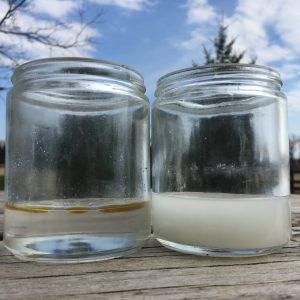Tank Mixing 101
The following information is a brief summary of a presentation given by Jason Deveau (“Spray Guy”) on May 5, 2021 for the Cold Climate Grape Webinar Series. The concepts and practices discussed apply to all fruit crop growers.
Terminology
Suspension – heterogeneous mixture of a fluid and solid particles
Carrier – primary material used to allow a pesticide to be dispersed effectively
Adjuvant – substance added to a pesticide or pesticide spray mixture to enhance performance
Agitation – stirring or shaking
What is tank mixing?
Tank mixing is the practice of combining multiple crop protection products into a single tank to make a single spray application. Tank mixing allows for the treatment of various pests with a single pass.
Why do we tank mix?
- Efficiency – Passing through the field once instead of several times – saves time and money! Additionally, you can avoid possible crop damage by reducing the number of times you pass through with equipment that could be damaging to the crop. Fewer passes in the field also reduces compaction of soils.
- Resistance management – multiple modes of action to prevent and reduce fungicide resistance issues.
- Improved performance – adjuvants such as stickers/spreaders can improve spray quality and reduce drift.
Why might we avoid tank mixing?
- Chemical or biological incompatibilities – chemicals can act synergistically or antagonistically in a tank mix. The symptoms of these reactions may never be apparent or occur immediately upon mixing.
- Synergism of chemicals can increase potency which can harm the plants.
- Antagonism of chemicals can reduce potency which can interfere with how the product works.
- Physical incompatibilities – can result in reduced productivity of your spray operation if you have to empty the tank due to chemistries not mixing well ex. liquid chemistries can solidify and clog plumbing, and dry products can fail to suspend in the tank mix (water) and can clog screens and nozzles.
What can cause issues with suspensions in tank mixing?
- Not agitating the tank frequently enough
- Using spray equipment with low carrier volume
- Mixing when carrier temperature is low
Mixing order matters!
- If your carrier is water the tank should be ½ full of water before adding the first product; if your carrier is a fertilizer the tank volume should be ¾ full of water before adding the first product
- Check the quality of your carrier water by establishing a baseline for:
- pH
- Total hardness
- Bicarbonate
- Salinity or Total Dissolved Salts
- W.A.L.E.S. – this acronym represents different categories of products you would typically include in a tank mix; see a more detailed overview of the different products within each category in Jason’s presentation
- Wettable powders
- Agitate
- Liquid flowables
- Emulsifiable concentrates
- Surfactants
- Compatibility agents and anti-foamers should be added before pesticides; adjuvants should be added based on label direction or based on their formulation
How to avoid tank mixing issues?
- The more products you tank mix, the greater the chance for incompatibility.
- Decide what you are planning to tank mix before you tank mix; do not make these important decisions while you are loading up your sprayer.
- Contact the manufacturer of the products you are using, extension educators and specialists.
- Consult the pesticide label!
- TIP: Use the PDF version of the pesticide label to search (CTRL+F on a PC or Command+F on a Mac) for potential tank mixing related issues using the following key words:
- Do Not Mix
- Mix
- Hours
- Agitation
- Fertilizers
- TIP: Use the PDF version of the pesticide label to search (CTRL+F on a PC or Command+F on a Mac) for potential tank mixing related issues using the following key words:
- PDF versions of pesticide labels are available at Agrian and CDMS

Image credit: Mike Cowbrough, University of Guelph
Tips and Tricks:
- Mixing takes time! Especially when you have a cold carrier or using dry products. Do not rush or you may risk product(s) not being fully suspended in the carrier.
- What if you do not know if certain chemistries are compatible? Try the jar test which can indicate physical incompatibilities of products. You can also purchase a Compatibility Test Kit (ex. Precision Laboratories Compatibility Test Kit).
Other considerations
As product registration may change from year to year, it is important to check if the pesticide you intend to use is registered with the Wisconsin Department of Agriculture, Trade and Consumer Protection (DATCP). As you know, state registration is mandatory for the use of products in Wisconsin and compliance is essential to avoid potential legal issues. To comply, you can always use the DATCP pesticide database that has the current registration status for each product registered in Wisconsin, sites products can be applied to, pests targeted, and more. This website is searchable by product name or by active ingredient which makes it very convenient to check a specific product.
Additional resources:
Tank Mix Compatibility – https://sprayers101.com/tankmix/
Sprayer Loading and the Jar Test – https://sprayers101.com/loading-jartest/
Avoiding Tank Mixing Errors – https://ppp.purdue.edu//wp-content/uploads/files/PPP-122.pdf
DATCP pesticide database website: https://www.kellysolutions.com/wi/pesticideindex.asp
*New Edition (2021) — Airblast 101 – Your Guide to Effective and Efficient Spraying
Order the eBook (free) or purchase a printed copy – https://sprayers101.com/airblast101/
This article was posted in Disease, Insects and tagged Christelle Guédot, Leslie Holland, tank mixing.
